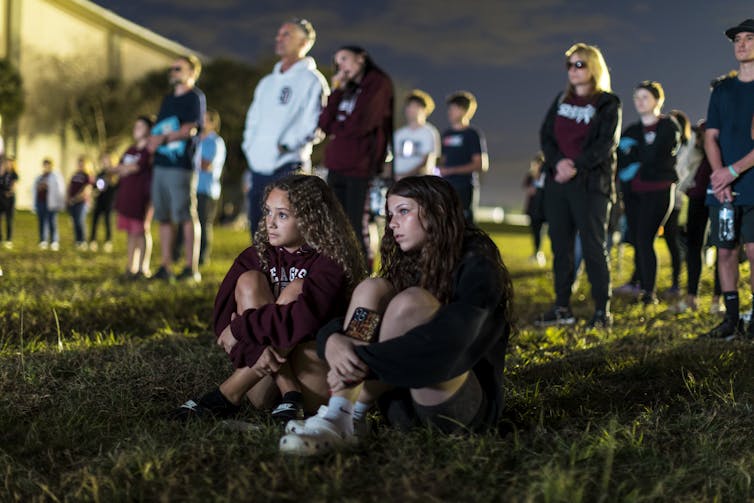Florida’s school safety dashboard helps parents and teachers address root causes of bullying, fighti
Florida’s school safety data dashboard is one of the most comprehensive in the US. A school safety researcher explains how schools and parents can use it.

Florida updated its school safety dashboard in April 2024, and it is now one of the most comprehensive in the nation. F. Chris Curran is an education policy professor at the University of Florida who partnered with Safe Schools for Alex, a nonprofit created by Max Schachter following the murder of his son Alex in the Parkland massacre in 2018, to release the new version of the dashboard. The Conversation asked him how parents and schools can benefit from the dashboard and what other states might learn from it as well.
What can this dashboard show parents about how safe a school is for their child?
Parents can use the Safe Schools for Alex dashboard to compare safety metrics in their child’s school with district and state averages as well as with other similar schools. The dashboard includes all public K-12 schools in Florida and over 50 indicators of school safety – ranging from fights and weapons to school bus crashes. Parents can also see information on school responses and resources, such as whether school staff are trained in suicide prevention and the ratio of counselors to students.
Access to this data lets parents and parent-teacher associations know what questions to ask of their teachers and school leaders to help them contribute to school improvement plans. It can also help parents better support their own children at home by talking about and addressing issues they see in the dashboard. For example, parents might talk to their kids about bullying or hazing, using the statistics in the dashboard.
With numerous measures of school safety at their fingertips, parents can look for the indicators that meet the needs of their individual child. For example, a parent with a child dealing with anxiety or depression might compare the mental health resources available at different schools.

How can schools use the dashboard?
School districts and educators can see their school safety data in relation to other schools and districts – and how such data relates to standardized test scores, community violence and other indicators. So, for example, a school might see an increasing trend in its community of students in poverty or living without health insurance and focus on connecting families with external social support resources. In contrast, a school that sees increases in school incidents despite improving community indicators might instead focus on improving school engagement and disciplinary responses.
In partnership with Safe Schools for Alex, my team also developed training that uses the dashboard to start conversations about school safety and find solutions. School leaders can use the dashboard to identify areas of concern in their own school – such as an increasing pattern of fights. The dashboard and the training then facilitate conversation about root causes of the issue. The dashboard’s list of resources provides evidence-based approaches to developing and implementing solutions. For example, school leaders might find a new bullying prevention program to implement or identify another school with decreasing fights to reach out to and learn from.

Could there be unintended consequences?
Unfortunately, research has shown that data dashboards can result in a stigma toward certain schools and lead to more affluent families leaving those schools. Public rankings of schools have been linked to increases in economic, racial and educational segregation. Lower-ranked schools, in turn, can lose enrollment and resources as wealthier parents opt for higher-ranked schools.
The Safe Schools for Alex dashboard purposefully avoids ranking or labeling schools as “safe” or “unsafe” for this reason. The dashboard includes a range of indicators so educators and parents can avoid a simplistic view of a school as safe or not. While parents often want a single indicator of a school’s performance, such indicators often misrepresent safety or achievement, as they tend to be more indicative of other factors, such as the poverty level of students served.
What does the dashboard reveal about violence in schools today?
Schools nationwide have reported increases in student misbehavior over the past several years. The dashboard shows this increase too. However, while some of the increase in safety-related incidents is due to violence such as fights, a large part is driven by nonviolent incidents – particularly vaping.
The data also shows that while rates of some incidents are increasing, so are state resources such as funding for school safety and mental health. Specifically, state funding per student for mental health has doubled from about $24 per student to $48 per student in Florida over the past five years. Meanwhile, funding for implementing security practices such as hiring school police officers has increased by about 15%.
Ultimately, the dashboard reveals that there is a lot of variation across schools and districts. Some have high and some have low rates of violence; some are increasing and some are decreasing.

What’s next?
School safety is a top priority of students, parents and educators. Just as schools have embraced the use of data to improve academic instruction, the use of data to ensure school safety is also growing. Yet, we have found that a quarter to a third of states currently do not make school safety or discipline data publicly available.
Along with the Florida dashboard, Safe Schools for Alex has dashboards for Kentucky, Pennsylvania, New Hampshire and Virginia. These other dashboards are in the process of being enhanced to include more data and features like the Florida one.
A number of other states, including Georgia, have their own dashboards that similarly include wide-ranging data points and interactive features. And some states, such as Kentucky, have integrated such measures into their broader school report cards.
These dashboards do not have all the answers, but they can help parents and school leaders know what questions to ask and where to find resources to make schools safer, fairer and more conducive to learning.
F. Chris Curran works with Safe Schools for Alex on the development of the school safety dashboard. He receives funding from the Bureau of Justice Assistance.
Read These Next
School shootings dropped in 2025 - but schools are still focusing too much on safety technology inst
Prevention methods like lockdown drills do not account for many scenarios, including the likely case…
From record warming to rusting rivers, 2025 Arctic Report Card shows a region transforming faster th
The 20th anniversary of the annual report tracks how sea ice, snow cover and many other vital signs…
How rogue nations are capitalizing on gaps in crypto regulation to finance weapons programs
North Korea was behind a $1.5 billion digital bank heist in February 2025. Other countries are similarly…




